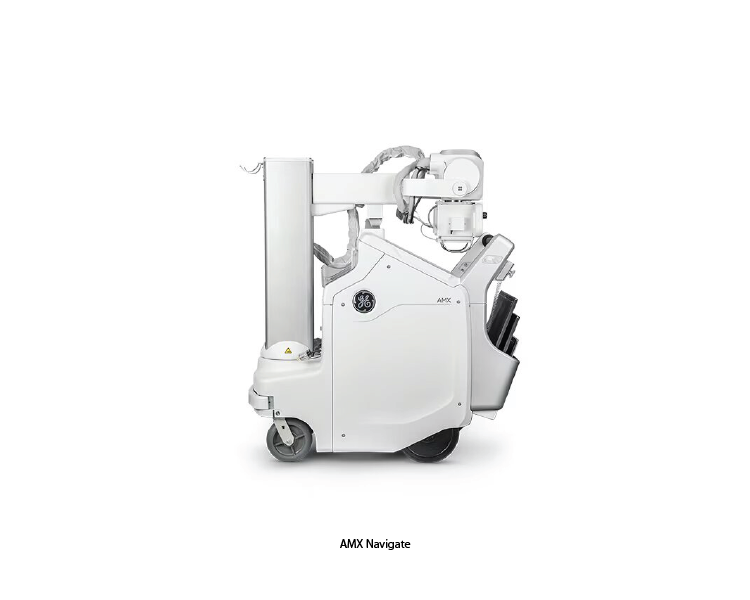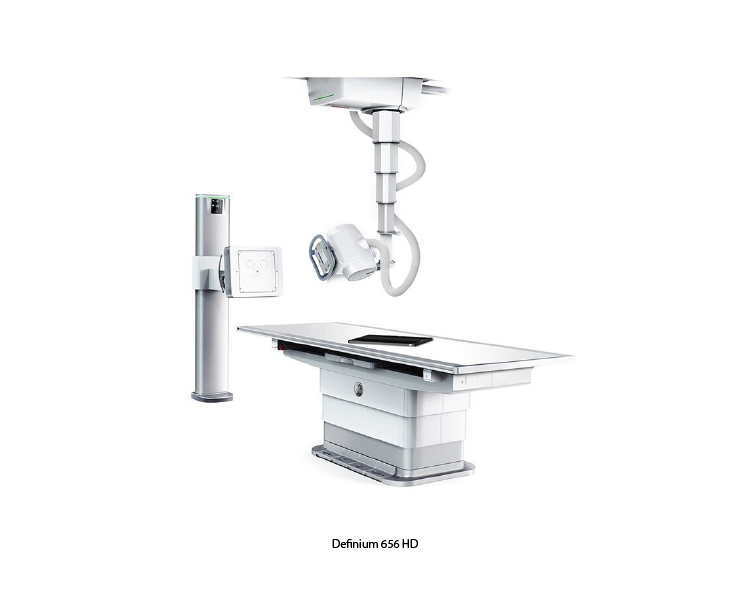AMX Navigate
The AMX Navigate is an advanced mobile digital radiography system designed by GE Healthcare. It aims to provide high-quality imaging with enhanced mobility, ease of use, and patient safety. Here are some key features and benefits of the AMX™ Navigate:
Key Features of AMX Navigate:
1. High-Quality Imaging:
• Advanced Detector Technology: Equipped with a high-resolution digital detector that delivers excellent image quality with fine detail and contrast.
• Image Processing Software: Utilizes advanced image processing algorithms to enhance image clarity and diagnostic accuracy.
2. Enhanced Mobility:
• Compact and Portable Design: The system is designed for easy maneuverability in various clinical environments, including emergency rooms, intensive care units, and patient bedsides.
• Wireless Capabilities: Wireless data transmission allows for seamless integration with hospital information systems (HIS) and picture archiving and communication systems (PACS), facilitating efficient image management and sharing.
3. User-Friendly Interface:
• Intuitive Touchscreen: Features a large, easy-to-use touchscreen interface that simplifies operation for radiologic technologists.
• Automated Workflows: Streamlined workflows and automated processes reduce the time required for imaging procedures, enhancing productivity.
4. Patient Safety and Comfort:
• Low Dose Imaging: Incorporates advanced technology to minimize radiation exposure while maintaining high image quality, ensuring patient safety.
• Ergonomic Design: Designed to provide comfort for patients of all sizes and conditions, reducing stress and discomfort during imaging procedures.
5. Versatile Clinical Applications:
• Broad Range of Exams: Suitable for a wide variety of radiographic exams, including chest, abdomen, skeletal, and more.
• Specialized Imaging Options: Can be used in diverse clinical settings, from routine exams to complex cases requiring detailed imaging.
6. Robust Battery Life:
• Long-Lasting Power: Features a high-capacity battery that allows for extended use without frequent recharging, making it ideal for busy clinical environments.
Clinical Application of AMX Navigate:
1. Emergency Medicine:
• Trauma Imaging: Provides rapid and accurate imaging for trauma patients, enabling quick assessment of injuries and guiding emergency interventions.
• Portable Chest X-Rays: Essential for diagnosing and monitoring conditions such as pneumonia, pneumothorax, and heart failure in emergency settings.
2. Intensive Care Units (ICUs):
• Bedside Imaging: Facilitates imaging of critically ill patients without the need to transport them to the radiology department, reducing the risk of complications and improving patient safety.
• Monitoring and Follow-Up: Allows for frequent imaging to monitor the progress of patients with severe conditions, such as ARDS (Acute Respiratory Distress Syndrome) or post-operative complications.
3. Operating Rooms (ORs):
• Intraoperative Imaging: Provides real-time imaging during surgical procedures, assisting surgeons in accurately placing implants, verifying the removal of foreign objects, and assessing surgical outcomes.
• Guided Interventions: Supports various guided procedures, such as catheter placements and orthopedic interventions, by providing clear and detailed images.
4. Pediatric and Neonatal Care:
• Gentle Imaging for Pediatrics: Offers pediatric-specific imaging protocols that minimize radiation exposure while delivering high-quality images, crucial for the sensitive population of newborns and young children.
• NICU Imaging: Enables bedside imaging in neonatal intensive care units, allowing for the monitoring and diagnosis of conditions in premature and critically ill infants without disturbing them.
5. General Radiography:
• Routine Examinations: Suitable for a wide range of general radiographic examinations, including skeletal surveys, abdominal imaging, and extremity imaging.
• Point-of-Care Imaging: Enhances the ability to provide diagnostic imaging at the point of care, improving patient throughput and satisfaction.
Definium 656 HD
The Definium 656 HD is a high-definition digital radiography system developed by GE Healthcare. This advanced imaging system is designed to deliver exceptional image quality, improve diagnostic accuracy, and enhance workflow efficiency in clinical settings. Here are some key features and benefits of the Definium 656 HD:
Key Features of Definium 656 HD:
1. High-Definition Imaging:
• High-Resolution Detector: Equipped with an advanced high-resolution digital detector that provides outstanding image quality with exceptional detail and contrast.
• Advanced Image Processing: Utilizes sophisticated image processing algorithms to enhance image clarity and diagnostic confidence.
2. Efficient Workflow:
• Automated Positioning: Features automated and programmable positioning to reduce exam times and improve patient throughput.
• Intuitive User Interface: User-friendly interface and controls simplify operation, making it easier for technologists to perform exams efficiently.
3. Versatile Imaging Capabilities:
• Wide Range of Exams: Suitable for a broad spectrum of radiographic exams, including chest, abdomen, skeletal, and more.
• Flexible System Configuration: Offers various configurations and options to meet the specific needs of different healthcare facilities.
4. Patient Comfort and Safety:
• Low Dose Imaging: Advanced technology ensures high-quality images at a reduced radiation dose, enhancing patient safety.
• Ergonomic Design: Designed to accommodate patients of all sizes and conditions, providing comfort and ease during imaging procedures.
5. Enhanced Diagnostic Tools:
• Stitching Capability: Features automatic stitching for full-length spine and long bone imaging, creating seamless composite images for accurate assessment.
• Dynamic Imaging Options: Some models may include dynamic imaging capabilities for specialized exams, such as those requiring real-time assessment.
Clinical Application of Definium 656 HD:
1. Chest Imaging:
• Diagnostic Chest X-Rays: Provides high-resolution images of the chest, essential for diagnosing conditions such as pneumonia, tuberculosis, lung cancer, and other thoracic diseases.
• Follow-Up Imaging: Ideal for monitoring the progression of pulmonary conditions and assessing the effectiveness of treatments.
2. Skeletal Imaging:
• Bone and Joint Studies: Delivers detailed images of the skeletal system, aiding in the diagnosis of fractures, dislocations, arthritis, and other musculoskeletal disorders.
• Orthopedic Assessments: Useful in preoperative and postoperative evaluations of orthopedic patients, ensuring precise alignment and healing of bones.
3. Abdominal Imaging:
• Abdominal X-Rays: Provides clear images of the abdominal cavity, helping to diagnose gastrointestinal issues such as bowel obstructions, perforations, and the presence of foreign objects.
• Urological Studies: Supports imaging for urological evaluations, including assessments of kidney stones and other urinary tract conditions.
4. Pediatric Imaging:
• Pediatric Protocols: Equipped with pediatric-specific imaging protocols that minimize radiation dose while delivering high-quality images, essential for the safety and care of young patients.
• Neonatal Imaging: Suitable for imaging neonates in intensive care units, providing critical diagnostic information with minimal disruption to the infants.
5. Emergency and Trauma Imaging:
• Rapid Trauma Assessment: Facilitates quick and accurate imaging of trauma patients, crucial for immediate diagnosis and treatment in emergency settings.
• Mobile Imaging Capabilities: Some configurations may offer mobile imaging options, allowing for bedside examinations in emergency and critical care environments.
6. Specialized Examinations:
• Spine Imaging: Produces detailed images of the spine, aiding in the diagnosis of spinal injuries, degenerative diseases, and other vertebral conditions.
• Soft Tissue Imaging: Provides excellent contrast resolution for imaging soft tissues, useful in evaluating soft tissue masses and other anomalies.


